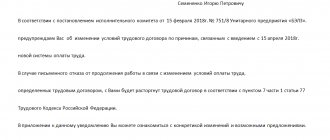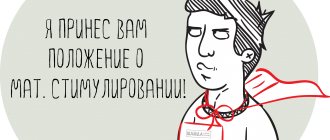What types of incentives are used for conscientious work?
[ads-pc-3] [ads-mob-3]
Types of employee incentives include declarations of gratitude, awarding certificates and awards, presenting valuable gifts, and awarding bonuses.
Rewarding employees in the form of gratitude is the simplest and most common way of incentives. To express it, the head of a structural unit submits a report or memo to the director describing the results achieved and a request to recognize outstanding employees in a solemn atmosphere.
Awarding diplomas or letters of gratitude can be carried out at several levels: enterprise, municipality, federal subject or at the federal level.
To submit for this award, one report is not enough. Here, work experience, high performance indicators of the employee, attitude towards work, etc. are taken into account. If the level of award goes beyond the scope of the company, then its management is required to submit a petition to the relevant authorities.
A valuable gift differs from a bonus in that it is expressed in kind. However, its cost must be indicated in the same way as premiums, since they are subject to personal income tax in certain cases.
The company's bonus regulations provide for all aspects of the latest incentive option. It should list in detail for what achievements and in what amount the bonus will be paid. To ensure that the tax authorities do not have questions about the economic justification of expenses, it is advisable to provide for bonuses for employees in the collective agreement and in the labor agreements concluded with them.
Rewarding employees, regardless of type, is carried out on the basis of reports and memos or other documents from their immediate supervisors. The director reviews the submitted submissions and notes his decision on each of them. After this, the responsible person (HR inspector, economist), in accordance with the indicators based on the “Regulations on remuneration”, “Regulations on bonuses” and other regulations of the company, determines the type and amount of incentives.
Bonuses can be given not only for high performance results, but also for compliance with labor discipline, as well as in cases provided for in the employment contract. In this case, a memo regarding bonuses from officials is not submitted. The HR department checks that the work and behavior of employees comply with established requirements (for example, the absence of disciplinary sanctions).
The incentive must be formalized by order of the head of the company. For this, the unified form T-11 can be used or an order can be issued on company letterhead in any form.
Specialized programs contain a standard T-11 form.
After the promotion order is issued, it is submitted to the director for signature and registered in the order book. The employee must be familiarized with its contents against signature. Orders for promotion can be announced in a solemn atmosphere (especially in cases of professional holidays, company anniversaries, etc.
To increase labor discipline and production indicators, various organizations often practice comprehensive measures of incentives for work and punishments for shoddy work. If we rely on the Labor Code of the Russian Federation, in particular Article 191, on the part of the employer, incentives for employees can be expressed in the following:
- appointment of a bonus;
- formal thanks;
- donation of a valuable item;
- highlighting the employee as the best in the team;
- issuance of a certificate.
Also see “Types of bonuses and rewards: making a choice.”
You can reward any employee who works in an organization under an employment contract (paragraph 4 of part one of Article 22 of the Labor Code of the Russian Federation). Moreover, it does not matter whether he is a main employee or a part-time worker, whether he is working under a fixed-term contract or not. Formally, an employer can even nominate an employee against whom there is an outstanding disciplinary sanction for promotion. Although, of course, such a situation is difficult to imagine.
Labor legislation provides for the following types of incentives for employees: declaration of gratitude, issuance of a bonus, awarding a valuable gift, a certificate of honor, nomination for the title of the best in the profession (part one of Article 191 of the Labor Code of the Russian Federation). The employer has the right to expand this list and use additional types of incentives for conscientious employees (part two of Article 191 of the Labor Code of the Russian Federation).
For example, presenting a badge, conferring the honorary title “Honored Worker,” placing information about the employee on the honor board, awarding a voucher to a sanatorium, etc. For special labor services to society and the state, employees can be nominated for state awards (part two Article 191 of the Labor Code of the Russian Federation, Regulations approved by Decree of the President of the Russian Federation of September 7, 2010 No. 1099).
The types of incentives used in the company are fixed in the collective agreement (if any), the internal labor regulations (Article 41, part four of Article 189 of the Labor Code of the Russian Federation). You can develop local regulations on specific types of incentives, for example, regulations on a corporate award or title.
No later than a week from the date of publication of the order, an entry about the promotion must be made in the work book (part four of Article 66 of the Labor Code of the Russian Federation, clauses 10, 24 of the Rules for maintaining and storing work books, approved by Decree of the Government of the Russian Federation of April 16, 2003 No. 225, further – Rules for maintaining and storing work books). For this purpose, it provides a special section: “Information about awards (incentives).” The following information is entered into the work book:
- on awarding state awards on the basis of relevant decrees and other decisions;
- on awarding certificates of honor, badges, badges, diplomas, certificates of honor, and conferring titles by the employer;
- on other types of incentives provided for by the legislation of the Russian Federation, as well as collective agreements, internal labor regulations, charters and regulations on discipline.
The full (22) and abbreviated (if any) (23) name of the organization is indicated as the title. In column 1 enter the serial number of the entry (24). In this case, increasing numbering is applied throughout the entire period of the employee’s working activity. Column 2 indicates the date of award (25). In column 3 they write down who awarded the employee, for what achievements and with what award (26), in column 4 indicate the details of the order on the basis of which the entry is made (27) (section 4 of the Instructions for filling out work books, approved by the resolution of the Ministry of Labor of Russia dated 10 October 2003 No. 69).
How to properly reward employees
An employee's salary may consist of a salary and bonus parts. The salary part has its own minimum threshold, indicated by the minimum wage rates, but the bonus part does not have any maximum limits. In other words, the manager decides whether to assign a bonus to an employee or not, and he also determines the size of the bonus.
One of the ways to reward an employee for successful work and achieving high results in work is a bonus. The employer is interested in increasing the efficiency of the company's performance indicators, therefore it has the right to motivate employees in the form of bonuses. To formalize the decision, an administrative document such as an order for a one-time bonus is used (if we are talking about only one employee). There are details that are recommended to be used in this form. A sample order for bonuses for employees can be found in the appendix via the link.
Orders to encourage employees: sample
If you have become familiar with other acts of the employer (an order to hire, an order to send on a business trip, etc.), then you most likely noticed the use of certain forms. The form of the order to encourage an employee is confirmed by the State Committee for Statistics of Statistics dated January 5, 2004 No. 1. This is form 11-T (for one employee) and 11-a (for a group of employees).
Although such samples are not required for use, in practice the forms are used by HR employees everywhere. First of all, it's convenient. Secondly, a sample form is available on any legal resource or on the Internet.
An employer can draw up his own sample order to reward an employee. Then the personnel must use the form approved by the organization.
There must be a basis for any employer document. And encouragement is no exception. Typically, the employee's immediate superior prepares the proposal for incentives. It indicates the employee’s personal information, gives a brief description of the place of work and a conclusion. The employee performed his job duties well.
Or achieved success in work. Maybe the employee’s work was effective (for example, it exceeded the plan), etc. The author of the order must refer to the Internal Labor Regulations and (or) the Regulations on Bonuses. These documents, as a rule, contain the basic formulations for which the employer rewards the employee.
An employer has the right to apply several types of incentives to an employee at the same time. This can be done with one order.
The Labor Code does not establish the procedure for applying incentives, so it can be established by local documents (Article 8, 191 of the Labor Code of the Russian Federation). In practice, the initiator of incentive measures is usually the employee’s immediate supervisor. It provides an idea of how to reward an employee (sample below).
The submission shall indicate the name of the organization (1), full name. the head of the organization or another person authorized to make decisions on rewarding employees (2), date, place of preparation and serial number of the document (3), full name. employee, the name of his structural unit (4), characteristics of the employee, his achievements and merits (5), type of recommended incentive (6). The document is signed by the immediate supervisor (7), and, if necessary, also by the head of the HR department or HR manager (8).
The employer can make a decision both in relation to one employee and in relation to several employees. In any case, an order to encourage employees is drawn up: a completed sample is given below.
Reference. A special unified form is provided for issuing an order for incentives. And if one employee is awarded, the order is issued in Form No. 11. If the employer has decided to reward several employees at once, the order is issued in Form No. 11a.
Please note that the use of unified forms is currently not mandatory. Therefore, the organization can develop and approve its own form of such an order. Meanwhile, in practice, many companies continue to use unified forms. It's convenient and familiar. These forms contain all the necessary information that must be present in the primary document.
surname, name and patronymic of the employee in respect of whom the order is issued;
employee's position;
the structural unit in which he works;
type of incentive used;
incentive amount. This information must be indicated if incentives are applied in the form of a bonus payment.
This order, as well as all other administrative documents, is signed by the head of the company. The employee must be familiarized with the order and signed.
An example of filling out an order to encourage an employee
An order to reward an employee (sample) must be issued whenever the employer makes a decision to reward an employee. The order is an administrative document on the basis of which the employee is rewarded. In addition, this document names the type of employee award.
Please pay attention! Labor legislation does not prohibit the application of several types of incentives to an employee at once. For example, an employee may be awarded a certificate of honor and an additional bonus may be paid to him.
How can you encourage an employee?
An employer interested in the development of his company cannot leave to chance such an important and effective element as employee incentives.
The issue of organizing a reward system in a company requires the administration to work painstakingly with staff. Each member of the work team is individual in character, behavior, aspirations and goals. Therefore, a personal approach is required.
The same type of reward can cause different reactions in different employees. At the same time, we must not forget about the adequacy of the efforts expended by the employee and the degree of his encouragement.
For example, an employee who completed a huge amount of work under intensive workload in connection with the commissioning of a new production line was rewarded with a certificate of honor. Such encouragement does not correspond to the efforts expended by the employee and is unlikely to contribute to further effective work impulses.
The employer needs to delve into the psychology of the members of the workforce in order to make effective incentive decisions. For example, for one employee, his photograph on the honor board means more than a large cash bonus, while another does not accept any form of encouragement other than material. Each of these workers, having received what they want, will be satisfied and stimulated to work.
There are several types of incentives:
- bonus (an example of a bonus order is in this article);
- valuable gift;
- gratitude - in written or oral form;
- certificate of honor;
- other forms: a tour to exotic countries, a photograph on the honor board, awarding the title “Best in the Profession”, etc.
Specific types of incentives and conditions for their application are provided for in internal local acts.
How to provide for bonuses and salary nuances in a company, see the material “Regulations on the remuneration of employees - sample 2017”.
How to correctly draw up an order for incentives in the T-11 form
The document must be formatted as follows:
- At the top of the document the name of the company and its registration code with the statistical authorities (OKPO) are indicated. The number of the order in order and the date of its execution are indicated.
- Below are the personal details of the employee nominated for the award, his personnel number, position and name of the structural unit in which he works.
- Next, it is necessary to indicate the basis for the award, which must comply with certain provisions of the company’s local acts.
- In the order, it is necessary to fill in information about the type of incentive, and if it is expressed in monetary terms, then the total amount of the reward must be written down in numbers and in words.
- After this, a link is provided to the documents with a breakdown of their details, on the basis of which the promotion is carried out.
- The order must be signed by the director of the company. Information about his position and full name are also filled in here.
- After reading the order, the employee puts his signature and the date of signing.
Lost reward and what to do
What to do if an employee suddenly loses a departmental award or certificate?
In this case, a duplicate can be issued, but only if the loss occurred in a combat situation, as a result of a natural disaster, or if it was impossible to prevent the loss (damage). In all other cases, only a certificate is issued stating that the employee has been awarded.
If a disciplinary sanction was imposed on an employee, and during the period of the sanction he came to his senses, so much so that he gave reason for encouragement, then the early lifting of the existing sanction may be an incentive measure, in accordance with paragraph 2 of Article 47 of 141-FZ
Awards against the law
Not all public awards of the Russian Federation were established and issued in compliance with the current legislation of the country. Back in 2008, by decision of the Supreme Court, the All-Russian public organization “Academy of Security, Defense and Law and Order Problems” was liquidated. The initiator of the liquidation was the Russian prosecutor Yu. Chaika, who in his statement accused the ABOP of the illegality of establishing and distributing distinctive signs that are identical to the state ones.
The organization itself existed for 8 years, since 2000. During this period, about 73 awards were established. ABOP awarded many famous people, even Gerard Depardieu, Margaret Thatcher, mother of Ramzan Kadyrov received honors. In addition to awards, the Society awarded special titles, for example: “Honored Lawyer of the ABOP”, “Honored Scientist of the ABOP” and so on. Along with the award of the title, badges, certificates and diplomas were issued. The most scandalous distinctive sign was the Order of Peter the Great, which had three degrees and was awarded for selfless acts, courage and other merits in civil life, in military service and in the performance of official duties.
These actions are similar to state awards and titles. In general, all these facts served as the basis for the liquidation of the Society and confiscation of distinctive signs. Although to this day, many public figures and ordinary citizens do not see any similarity in the distinctive signs of the ABOP and state awards. At not a single court hearing were the opinions of the Heraldic Council or the Commission on State Awards heard. The court limited itself to bare facts and dry formulations. In fact, it is quite difficult to see the difference in the current legislation between public awards and medals and those issued by the state.
In any case, public identification marks are a good incentive for a person to strive for heights and be an exemplary citizen of his homeland.





